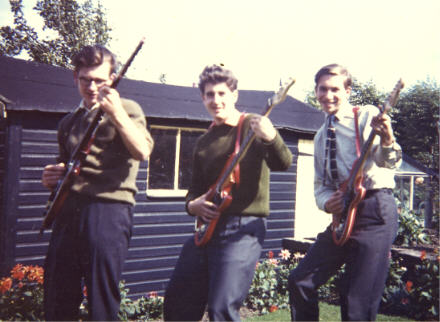

"The Telstars": 1962.
L. to R.: Myself with the Broadway, Richard Hewer with
Hofner Solid Bass, and Dave Thompson complete with vinyl covered Colorama II.
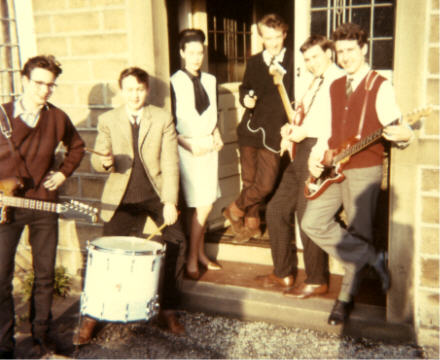
"The Fieu-gatives": 1963
L to R: Me with the Hofner V3, Tim
Collins on drums, Jane Brahm as the Manager, Dave Maffin on Vocals, Dave
Thompson with Hofner Colorama II, and Richard Hewer with Hofner 182 Solid Bass.
Improved amplification was a far greater hurdle to overcome. In late 1962 there were really only two options for professional quality guitar amplification in Britain; Vox and Selmer Truvoice. The most powerful models produced by these companies were both rated at
30w: the famous Vox AC30, and the Selmer Truvoice Twin Selectortone (later known as the Zodiac when it had acquired its crocodile covering and winking tremolo light). The Selmer had the advantage of a built-in reverb unit. The Vox had the credibility of being used by the Shadows. The bass player's father once again did the honourable thing and bought his son an AC30. The rhythm guitarist quickly followed with a new Twin Selectortone. As lead guitarist, my 15 watt Bird with its three heavily distorting
elliptical speakers was now totally outclassed. Being still at school, there was no way that I could afford the 105 guineas that the new 30w amplifiers retailed for.
Selmer's previous top of the range amplifier, before the introduction of the Twin-Selectortone, had been (guess what?) the Selectortone 25watt. This was
equipped with 15" speaker, tremolo, four inputs in two channels (no, they were
certainly not switchable!), and six preset tone boost push-buttons which gave a very good range and, I suppose,
was one-up on Vox who didn't come up with their Top Boost until around 1962. A rather battered second hand Selectortone, in Selmer's old livery of red and cream, had recently been traded in in by some lucky guy for a new AC30 at The Music Centre in Huddersfield. Seizing my chance, I traded in the Bird for this old workhorse. I was now more or less back in the running, but I had forgotten one
thing; the old Selectortone did not have built in reverb - essential for any chance of sounding like the Shadows. Only one thing for it
therefore....... sell the rest of my possessions (bike, train set, etc.) and buy an echo unit.
Binson, Vox, Meazzi, Dynachord, Selmer Swissecho, etc., were the units to go for in
Britain during early sixties, but only if you could afford the £100 or thereabouts, retail prices. These were all tape repeat machines. Delay pedals had not been invented. My budget, and that of most of my contemporaries, corresponded to the Watkins and cheaper Selmer tape echo boxes. Watkins had the Copicat, a three replay head, two input machine in a very practical and pleasing top-opening box. Dave, our singer, purchased one of these second hand from Barretts of Oxford Road, Manchester during one of our many pilgrimages to this Mecca of musical instruments. Selmer had, from memory, the 200 Model and the 300 Model. The cheaper unit had three replay heads and a hinged front for easy access to the tape. The 300 had four replay heads, a three input mixer, and a multi output panel. Access to tape and controls was from the top as with the Copicat, but for street cred' the Copicat had it. I went for the Selmer 300.
Echo replay quality on both the band's Copicat and Selmer was not good, probably made worse by our use of home made domestic quality tape loops, instead of those sold by the manufacturers. The Copicat sounded the better of the two, and an exchange was soon arranged in order that the vocals could take advantage of the Selmer's superior mixing system, and I could take advantage of a cleaner sound for my instrumental numbers. (The days of guitarists pursuing a heavily overdriven and distorted sound would not arrive for a further five years or so!) The multiple output of this unit also allowed the mikes to be fed into the AC30 and Twin Selectortone which, positioned at each side of the stage, could then double as a PA System. By the standards of the time, we now were sufficiently equipped to take on the larger venues in the area.
Our vocal repertoire up to that time had been very much early British rock - Cliff Richard,
Johnny Kidd, etc., with the occasional one from across the water such as Connie Francis' "Sweet Nothings". All this changed however in the late spring of 1963, when we supported a Manchester band at the local dance hall. Their performance was our first introduction, and probably Huddersfield's, to the heavily rhythm and blues orientated Merseyside/Manchester Sound which was about to take over the rest of the world in the mid 60s. Our music at that gig was weak and insipid compared to the Manchester lads' sound. Needless to say, we could see the future, and a full review and change of our repertoire
was immediately put in hand!
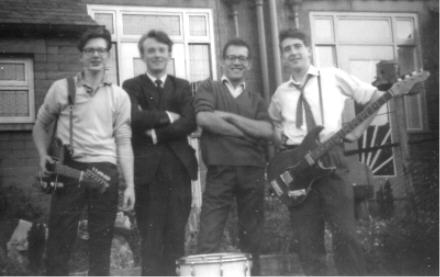
"D plus Four": 1963
L to R: Me again, Dave Maffin on Vocals, John Pashley on Drums, and Richard Hewer.
One major aspect of the new wave groups was their use of a whole range of alternative guitars to the Fenders that had been made so popular in Britain by
the Shadows. It seemed that overnight, solid guitars were out, and semi-acoustics were a necessity.
Gretsch, Gibson, and Rickenbackers were all over the television screen. I decided that, in order to obtain the right image, I too would have to change onto a semi, but without getting rid of the Hofner V3, to which I had become very attached. What was the choice in reasonable quality semi-acoustic guitars at that level of sensible price which would not need a trade in; obviously another Hofner!
Yet another pilgrimage to Barretts of Manchester, and the successful purchase of a second hand but immaculate Hofner President Thin Line in blonde. This guitar was about two years old when I bought it in late 1963. It had the toaster pickups and the classic
Hofner square control console. To tell the truth, I found the President quite difficult to play after the V3. The neck was much thicker, the action higher, and I found the body size to be more uncomfortable after the V3's small solid body. I therefore found myself using the President on stage for only those numbers that I fooled myself would sound better with a semi. Anything requiring dexterity and speed, and I quickly reverted back to the V3's slim neck!
I kept the President for a year or so, and then sold it to
John Verity, the band's current rhythm guitarist. Since then I have parted with many guitars, including an L-serial number
1962 Fender for £160, but my lasting regret is that I sold that President. I can only hope that its superb flame maple timbers and beautiful mother of pearl inlaid headstock are looking as well now as when I last saw it back in 1965!
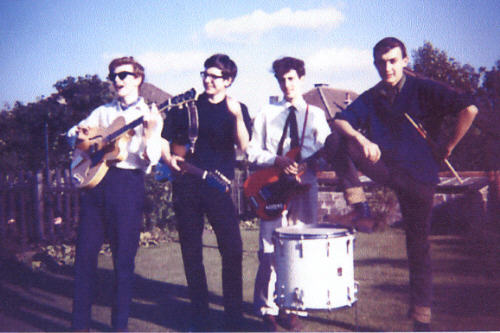
"The Clique": 1964
L to R: John Verity with my beautiful Thinline President, me still with the Hofner V3, Richard Hewer on Bass, and Tim Collins on Drums.
From around 1964 onwards, the availability of American instruments and amplification became commonplace in the UK. I can always remember going down to the Huddersfield Music Centre in June 1964, the day that I had finished my A-Level examinations, to examine the first Fender
amplifier, (I think it was a blonde Tolex piggy-back Bandmaster), that the store had been able to obtain. With their fashion credibility now much reduced by Gibson, etc., second hand Fender Strats became comparatively cheap. It was therefore around this time that sales of Hofners began to tumble. Paul McCartney's continuing use of the 500/1 Violin Bass helped to slow down the decline a little, and the Galaxies' extrovert styling seemed to appeal to some for a few more years. However, the writing was on the wall for Hofner in Britain by 1965.
For some of us, nostalgia is a powerful emotion, and in the late 1980s my memory turned back to those formative years. Advertisements for old Hofners appeared regularly in the back pages of such magazines as "Guitarist", and occasionally an old Senator could be seen hanging on a dark area of wall at the back of a music store, probably taken in part-exchange for a Squire or Pacifica. I realised that such
instruments (then!) could be purchased for a fraction of their true worth............That old Hofner Magic had got hold of me again!
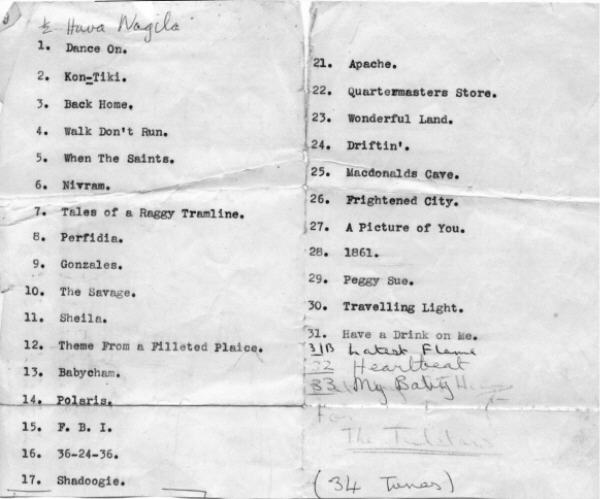
A Telstar's Set-List from 1962. Note the large percentage of instrumentals!
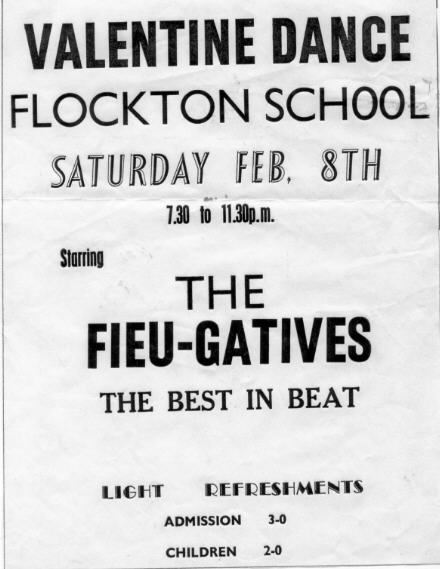
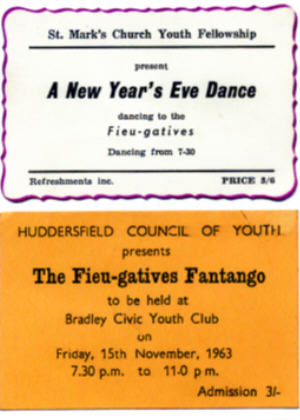
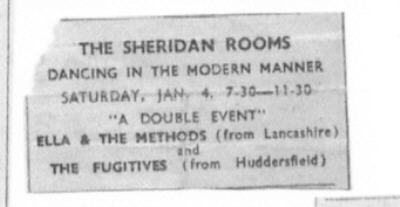
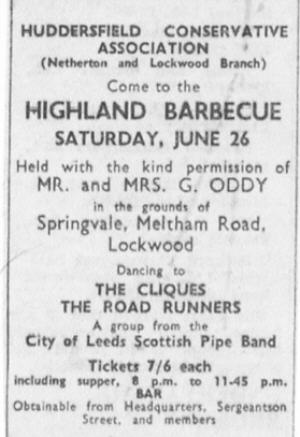
Many thanks to Richard Hewer for providing some
of the photos and the memorobilia above.